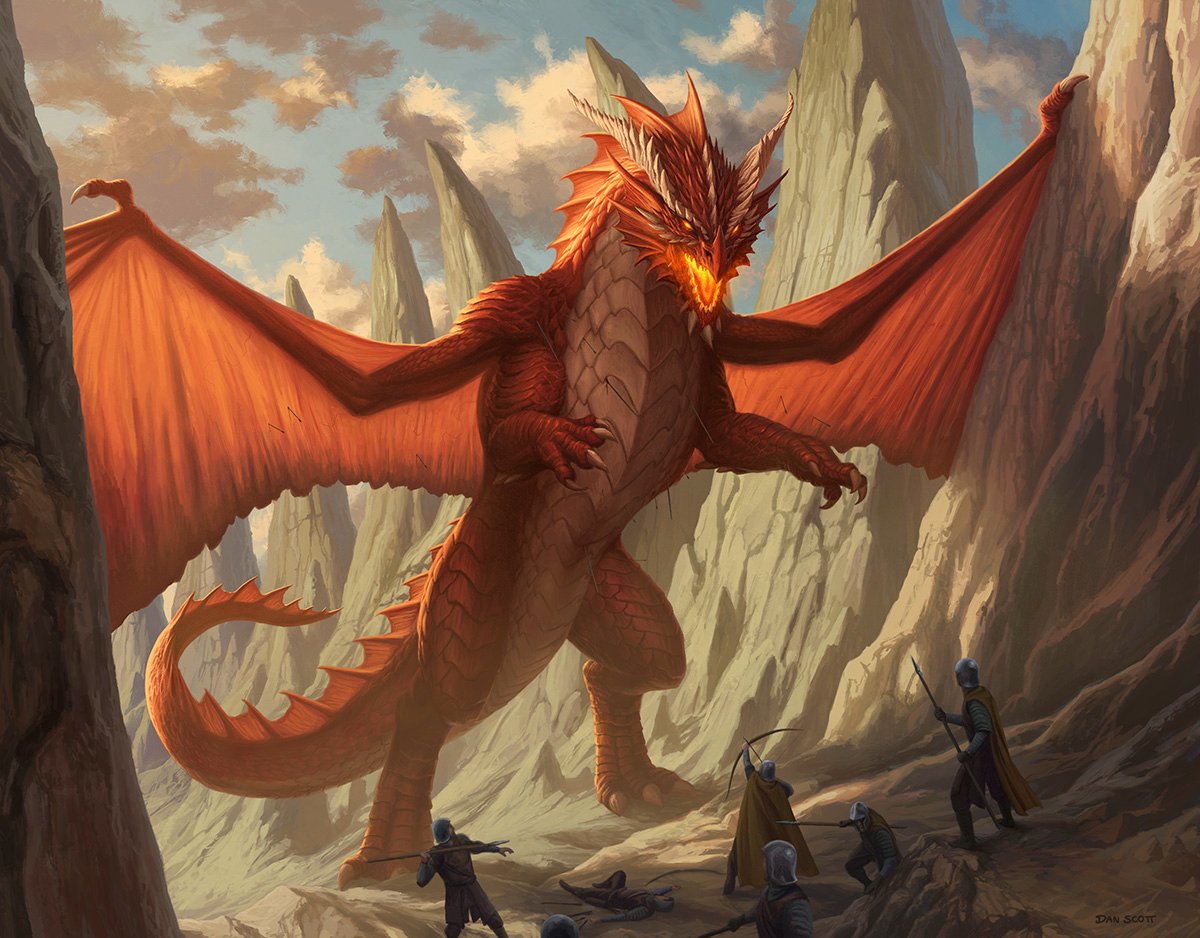Are you a Quiet Speculation member?
If not, now is a perfect time to join up! Our powerful tools, breaking-news analysis, and exclusive Discord channel will make sure you stay up to date and ahead of the curve.
Amidst the groaning over digital-only products, a new format emerged earlier this month. I delayed writing this article before realizing the inevitable: these changes are here to stay. While Alchemy cards may lack the elegance of traditional Magic the Gathering design, this set provides a new Limited environment on Arena. Changes like these might seem difficult to reconcile. However, just like the introduction of Planeswalkers and dual-sided cards, we will find room to appreciate these as part of the game's landscape.
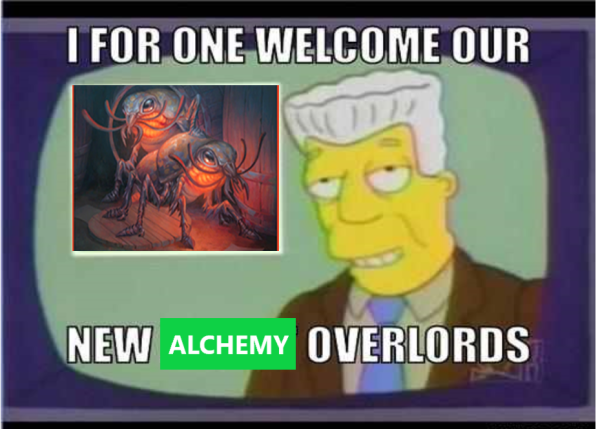
If you plan on drafting on Arena this summer, you will most likely be playing Alchemy Horizons: Baldur's Gate (HBG). With it comes new abilities, a deluge of digital-only keywords, and brand-new strategies to help give you the edge as you battle it out for seven (or three) wins.
Double-Team Warps the Format
Two new keywords, double-team and specialize, define HBG. The double-team ability makes curving out exceedingly easy, especially when written on cheap creatures like Genasi Rabble-Rouser and Soldiers of the Watch. As previously discussed, the ideal two-drop trades off and leaves something over. These cards don't just provide a resource, they generate a completely new copy of themselves. This means that if you and your opponent are trading two-drops and only yours has double-team, you are way ahead.
Double-team is very strong and aggressive in nature. When an aggressive keyword generates card advantage, you need to have a compelling reason to play a controlling strategy. Blitz incentivized aggression in Streets of New Capenna (SNC), but double-team really punishes slower decks in HBG.
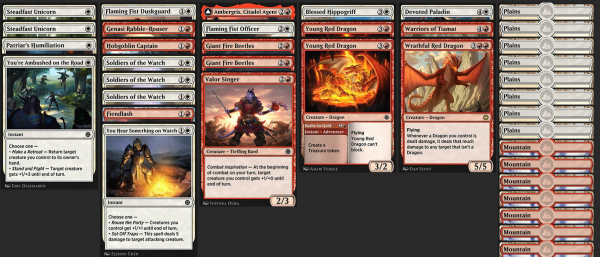
My first foray into HBG yielded a 7-2 finish. While this deck did have some strong rares (Fiendlash and Wrathful Red Dragon are both very powerful), double-team made me feel very confident from the early stages. The format has a decent amount of interaction, but it can't keep pace with the card advantage that comes from these creatures. They play out similar to the adventure mechanic, where each card feels like two. The gameplay reminds me a lot of SNC because your early aggression naturally provides more action down the road. The biggest difference I've noticed is that it's far easier to stabilize in HBG, whereas in SNC starting off behind felt like a death sentence.
Winning With, and Losing To, Specialize Creatures
Specialize creatures delivered the only two blemishes on my trophy run. Admittedly, that can happen when you're short on removal. Treat these creatures as bombs. They have a lot of text on them, so in the draft, you should be cycling through the colors that you have access to and skipping the others. They are all pretty good and should be high picks, though I would avoid the blue ones (more on this later).
My first loss came against Skanos Dragon Vassal. I expected to race the dragon until it was cloned with Irenicus's Vile Duplication. I lost soon after. Viconia, Nightsinger's Disciple delivered my second loss after stealing a Genasi Rabble-Rouser from my graveyard and pairing it with a few of my opponent's copies. The specialize creatures demand removal and I did not have enough to fend them off in those two games.
Ambergris, Citadel Agent was game-breaking every time it was activated. Its red-white side can easily generate +4/+4 to each attacker and ends games very quickly. Though I haven't played with every specialize creature, each seems to be a game-warping experience.
It's Not Easy Being Blue
We started with Adventures in the Forgotten Realms (AFR), a format where blue was nearly unplayable and maybe the only controlling color in the format. They added double-team to further punish controlling decks. They removed the best blue cards (which weren't even that good) and then added specialize, giving blue the worst of the bunch. How did we get here? Well, let's look at where we started.
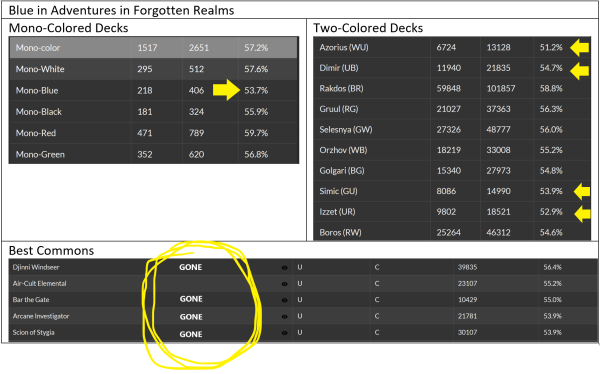
Removing Djinni Windseer and Scion of Stygia from the format slowed down blue's ability to play a tempo game. While Wizened Githzerai is a promising addition to that gameplan, the support is not there. The truth is blue is just bad. If you find a blue card you need to play, I would strongly advise only including it as a splash. Because as bad as the data was in AFR, it's only gotten worse in HBG.
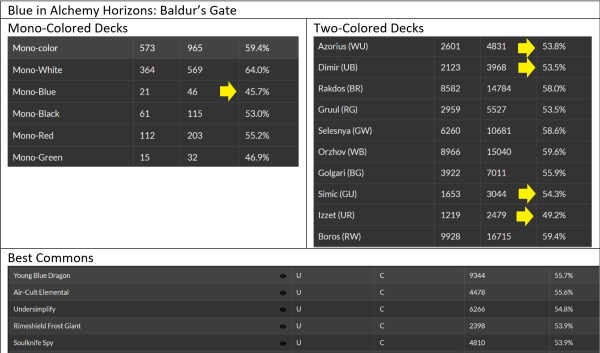
If those data points aren't convincing enough, I'd like to show you the list of top commons in the format. The first blue card appears as the thirty-fifth best common in the format. The second one comes in at thirty-eight.
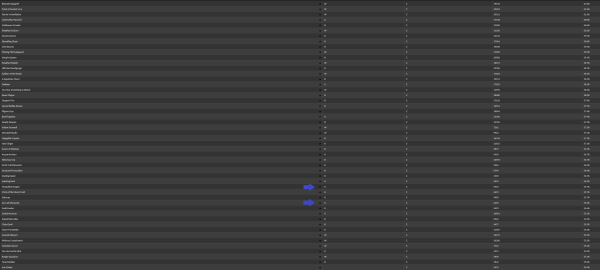
This was the largest font I could use to demonstrate the highest ranking blue commons in relation to the rest of the format's commons. In short, blue is unplayable. The creatures are too small. The gameplay can't keep up with the format. Its best cards should be splashed. I understand that draft is self-correcting, but even if you're the only player taking blue cards at the entire table, I still advise looking in a different direction.
What the Other Colors Do
Alchemy is an aggressive format and the Mardu colors (White, Red, and Black) do that better than the other two colors. Early on in the format, white seems to be the best option. It is deep at common with Blessed Hippogriff // Tyr's Blessing, Priest of Ancient Lore and Patriar's Humiliation ranking as the top three commons currently. The Humiliation is a brilliant removal spell and I would consider taking that over the other two because it is so easy to splash.
Both red and black provide an aggressive curve and removal. Currently, the data supports black as the second best color, but it's close and between the two it is unclear to me which is better. Any combination of the Mardu colors should be a powerful, aggressive deck assuming the colors are open.
Green plays a little differently. It offers tools for ramp in Undercellar Myconid and Scaled Nurturer, as well as larger threats to capitalize on this advantage. Doric, Nature's Warden // Doric, Owlbear Avenger and Hill Giant Herdgorger return and are joined by Dread Linnorm // Scale Deflection, providing powerful curve toppers at common. Band Together is a reasonable removal spell and Gnoll Hunter is probably your best two-drop.
As for blue...
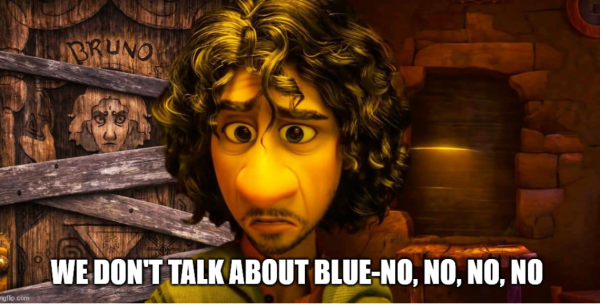
So Alchemy is a Disaster?
I have some issues with the Alchemy cards in general. However, Draft is basically fun no matter what. With SNC currently removed from Arena, Wizards of the Coast is not-so-subtly encouraging us to give this set a try. Yes, it has its flaws but it's still an enjoyable format. This is a new frontier for the design team and while it's easy to nitpick, it's probably just objectively better to jump in and enjoy the new format. Remember that in the early days of Magic: The Gathering design they thought Ancestral Recall and Healing Salve were part of a balanced cycle. These things have a learning curve.
You do, however, need to know the rules of engagement.
- Expect aggression and the double-team creatures do this better than anyone.
- Specialize cards are generally very strong.
- Interaction is valuable, as the high volume of specialize creatures demand answers.
- Green can ramp, but have a plan against aggression.
- The odds are against you if you want to be a control deck.
- Avoid blue like the plague. Although not like Sewer Plague which is a premium removal spell and should be taken highly.
Make sure that you're the one casting the double-team creatures early. It's hard to lose with that kind of a start. The specialize cards finish the job, but you can just beat opponents with a strong curve and some well-timed removal spells. Hopefully, this guide helps you Gatecrash your way to the top. Let me know in the comments what cards have over-performed for you!


